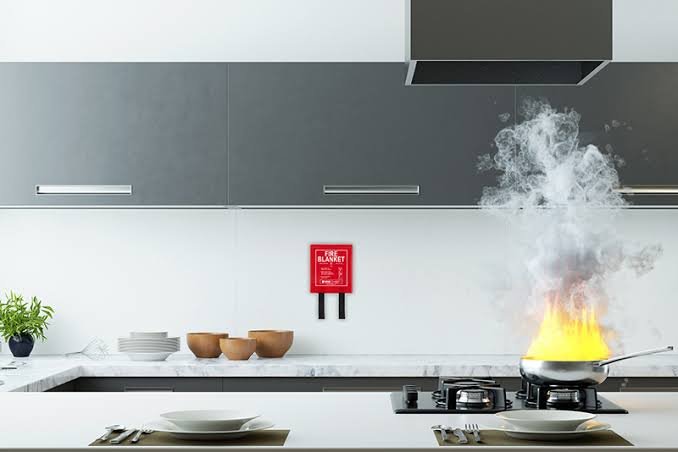Fire safety is a crucial aspect of maintaining a secure home environment. While we often think about smoke alarms, fire extinguishers, and escape plans, there’s one essential tool that shouldn’t be overlooked – the fire blanket. Designed to smother small fires before they escalate into something more dangerous, fire blankets are an effective and reliable defense against unexpected flames.
In this comprehensive guide, we’ll delve into the world of fire blankets – how they work, their different types and uses, as well as the benefits of having one in your home. We’ll also explore what features to look for when purchasing a fire blanket and discuss proper usage techniques for maximum effectiveness.
From kitchen mishaps to electrical malfunctions, knowing how to handle a potential fire emergency is crucial knowledge we all need. So let’s dive in together and discover everything you need to know about these life-saving tools that could make all the difference in protecting your loved ones and property!
How Do Fire Blankets Work?

Fire blankets are an essential tool in fire safety. When it comes to extinguishing small fires, they can be highly effective. But have you ever wondered how exactly fire blankets work? Let’s delve into the science behind these life-saving devices.
Fire blankets are made from special materials that are designed to resist high temperatures and prevent the spread of flames. The most commonly used material is fiberglass, which has excellent heat resistance properties. These blankets work by smothering the fire and cutting off its oxygen supply.
When a fire blanket is placed over a burning object or person, it forms a barrier between the flames and the surrounding air. By depriving the fire of oxygen, it helps to suppress the combustion process and eventually extinguish the flames.
The fiberglass material also acts as insulation, preventing heat from transferring through to other surfaces or causing further damage. This feature is particularly important when dealing with grease fires in kitchens or electrical fires where water cannot be used as a firefighting agent.
In addition to their flame-retardant properties, fire blankets also provide protection against radiant heat. They reflect and absorb thermal energy, reducing potential burns and injuries caused by exposure to extreme temperatures.
Fire blankets function as a crucial first line of defense during small-scale fires. They’re easy to use and can quickly smother flames before they escalate into larger emergencies. By understanding how these simple yet effective tools work, we can better appreciate their importance in promoting safety within our homes and workplaces.
Types of Fire Blankets and Their Uses

Fire blankets are available in various types, each designed for specific fire hazards. Understanding the different types can help you choose the right fire blanket for your needs.
1. Fiberglass Fire Blankets: These are commonly used and offer excellent protection against small fires caused by flammable liquids, such as gasoline or oil. Fiberglass blankets smother flames by cutting off the oxygen supply.
2. Wool Fire Blankets: Made from wool treated with flame-retardant chemicals, these blankets are ideal for extinguishing fires involving solid materials like wood or paper. They work by absorbing heat and suffocating flames.
3. Kevlar Fire Blankets: Kevlar is a strong synthetic material often used in bulletproof vests, making it highly effective at protecting against intense heat and large-scale fires. These blankets are suitable for industrial settings where there may be chemical or electrical hazards.
4. Aluminum-Coated Fire Blankets: Designed to withstand high temperatures, these specialized blankets reflect heat away from objects they cover while also providing insulation properties.
5. Silicone-Coated Fire Blankets: Best suited for kitchen environments, silicone-coated fire blankets have non-stick properties that allow them to smother grease fires effectively without sticking to hot surfaces.
Remember that choosing the right type of fire blanket is crucial as using an incorrect one may not provide adequate protection during an emergency situation.
Benefits of Having a Fire Blanket

One of the key advantages of having a fire blanket is its versatility. Unlike other firefighting equipment that may be specific to certain types of fires, fire blankets can be used for various situations. Whether it’s extinguishing small kitchen fires caused by cooking mishaps or wrapping around someone whose clothing has caught fire, these blankets are designed to smother flames quickly and effectively.
Another benefit is their ease of use. Fire blankets typically come with simple instructions and can be deployed by anyone, regardless of their level of training or experience in handling emergencies. This makes them an excellent choice for homes as well as workplaces where multiple individuals may need access to firefighting tools.
Furthermore, fire blankets are compact and lightweight, which means they can be easily stored in convenient locations such as kitchens or near potential sources of fires. Their portability also allows for easy transportation in case you need to take them along when traveling or camping.
Additionally, using a fire blanket reduces the risk associated with traditional firefighting methods like water or foam extinguishers that may spread flammable liquids or electrical hazards. By suffocating the flames without introducing additional agents into the mix, fire blankets minimize the chances of causing further damage during containment efforts.
Investing in a quality fire blanket provides peace of mind. Knowing you have this essential tool readily available should an emergency arise gives you confidence and helps ensure your safety as well as those around you.
Important Features to Look for in a Fire Blanket
When it comes to fire safety, having the right tools and equipment is crucial. One such essential item is a fire blanket. But with so many options available on the market, how do you know which one to choose? Here are some important features to consider when looking for a fire blanket.
1. Size: The size of the fire blanket should be suitable for its intended use. It should be large enough to completely cover an individual or small enough to fit into compact spaces if needed.
2. Material: Fire blankets are typically made from materials that can withstand high temperatures and extinguish flames effectively. Look for blankets made from flame-resistant materials like fiberglass or treated wool.
3. Certification: Ensure that the fire blanket meets industry standards and has been tested by reputable certification bodies such as UL (Underwriters Laboratories) or EN (European Norms). This ensures that it will perform reliably in case of an emergency.
4. Ease of use: In an emergency situation, every second counts. Choose a fire blanket with clear instructions and simple deployment mechanisms that anyone can understand and operate quickly.
5. Durability: A reliable fire blanket should be durable enough to withstand repeated use without compromising its effectiveness. Look for blankets with reinforced edges or stitching for added durability.
6. Storage container: Some fire blankets come with storage containers designed specifically for easy access and protection against dust, dirt, and moisture when not in use.
Remember, when purchasing a fire blanket, it’s essential to prioritize quality over price alone – after all, this could potentially save lives! By considering these important features during your search, you’ll be well-equipped with the right tool in case of a fire emergency.
Proper Usage and Maintenance of a Fire Blanket
Using a fire blanket correctly is crucial to ensure its effectiveness in extinguishing fires. When faced with a small fire, follow these simple steps to use the fire blanket safely:
1. Assess the situation: Determine if it is safe for you to approach the fire and use the blanket. If you feel unsure or threatened, evacuate immediately and call emergency services.
2. Unfold the blanket: Open the package carefully to avoid any damage or tangling of the material.
3. Cover the flames: Gently place the unfolded fire blanket over the flames, ensuring that it completely covers them. Use caution not to expose yourself to heat or smoke during this process.
4. Cut off oxygen supply: Once covered, tuck in any loose ends of fabric around the edges of the fire source. This helps prevent oxygen from reaching and fueling further combustion.
Now let’s talk about maintaining your fire blankets:
– Regular inspection: Check your fire blankets regularly for signs of wear and tear such as frayed edges or holes. If you notice any damage, replace it immediately.
– Cleaning: Clean your fire blankets according to manufacturer instructions, usually using mild detergent and warm water.
– Storage: Store your blankets in easily accessible areas away from potential hazards but within reach during emergencies.
By following these guidelines on proper usage and maintenance, you can maximize safety when dealing with small fires at home or in commercial settings without compromising their effectiveness!
Steps to Take in Case of a Fire Emergency
1. Stay calm and evaluate the situation: In the event of a fire emergency, it is crucial to remain calm and think clearly. Assess the severity of the fire and determine if it can be safely extinguished using available resources or if evacuation is necessary.
2. Alert others: Immediately notify everyone in the vicinity about the fire by shouting “Fire!” This will alert others to take necessary actions and evacuate if required.
3. Activate alarms: If there are fire alarm systems installed, activate them immediately. This will alert building occupants and trigger an automatic response from emergency services.
4. Evacuate safely: If evacuation is necessary, remember to follow established escape routes or exit signs. Avoid using elevators and instead use stairwells for safe passage.
5. Use fire extinguishers or blankets (if applicable): Only attempt to use firefighting equipment like fire extinguishers or blankets if you have been trained on their correct usage and feel confident doing so without compromising your safety.
6. Close doors behind you: As you leave each room during evacuation, close doors behind you to help contain smoke and flames, preventing further spread of the fire.
7. Call emergency services: Once outside, call emergency services right away with precise information about the location of the fire.
Remember that personal safety should always be your top priority when dealing with a fire emergency situation!
Conclusion
In this comprehensive guide, we have explored the world of fire blankets and their importance in fire safety. We learned about how fire blankets work by smothering fires and cutting off the oxygen supply. We also discovered the different types of fire blankets available on the market and their specific uses.
Having a fire blanket in your home or workplace can provide numerous benefits. It gives you an additional layer of protection against small fires and can help prevent them from spreading further. Fire blankets are easy to use and require minimal maintenance, making them a practical choice for anyone concerned about fire safety.
When choosing a fire blanket, it is important to consider certain features such as size, material quality, and certification. These factors ensure that you are getting a reliable product that meets industry standards.
Remember that proper usage and maintenance of a fire blanket are crucial for effectiveness. Familiarize yourself with its instructions so that you can quickly respond during an emergency situation.
While having a fire blanket is essential, it should not be your only line of defense against fires. It is important to have other safety measures in place such as smoke detectors, extinguishers, evacuation plans, and regular inspections.
By understanding how vital it is to be prepared for potential fires, you are taking proactive steps towards protecting yourself and those around you. Stay informed about best practices when it comes to fire safety – knowledge truly is power!
Keep yourself updated with any changes or advancements in technology regarding firefighting equipment like fire blankets so that you can always make informed decisions when it comes to keeping your loved ones safe.
Frequently Asked Questions About Fire Blankets
Q: How long do fire blankets last?
A: The lifespan of a fire blanket can vary depending on several factors, including its quality and how often it is used. However, most manufacturers recommend replacing them every five years or sooner if they show signs of wear or damage.
Q: Can I use a fire blanket more than once?
A: Yes, in most cases, you can reuse a fire blanket as long as it remains undamaged and has not been exposed to extreme heat. However, always follow the manufacturer’s guidelines for proper usage and maintenance.
Q: Are all fire blankets suitable for all types of fires?
A: No, different types of fire blankets are designed for specific classes of fires. It is crucial to choose the right type based on the potential risks in your environment. Make sure to check the labeling or consult with experts if you are unsure.
Q: Can children use fire blankets safely?
A: While children should be educated about basic firefighting principles from an early age, using a fire blanket should generally be left to trained adults. Ensure that children understand how to raise an alarm and evacuate safely during emergencies instead.
Q: Where should I store my fire blanket?
A: Ideally, store your fire blanket in an easily accessible location away from potential ignition sources but within reach in case of emergency. Common places include kitchens, workshops, garages, and near electrical equipment.




